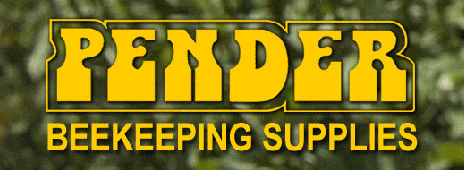W. S. Pender (Pender Brothers Ltd) Beekeeping Film (c.1926)
Original 16mm black and white motion picture reel, in all probability produced by William Samuel Pender of Pender Brothers Ltd (Maitland N.S.W.) displaying beekeepers and beekeeping practices across New South Wales.
The film records apiaries and processes employed in the manufacture of honey and the maintenance and use of hives and related equipment.
According to Powerhouse Museum, the Pender Brothers Ltd began manufacturing beekeeping equipment in 1892 and led the field for the next eighty years. In 1899 they started publishing The Australasian Beekeeper journal, also known as ABK, that continues today.
[Pender Brothers Limited, Maitland NSW] [Beekeeping Film] 16mm Black and White Film c.1926 09:39
0:03 – 01:46 Hawkesbury Agricultural College Apiaries male and female official visitors (?) examining apiaries, with scenes of stock yards.
01:47 – 02:56 Apiaries of Mr. Henry Edison, at Emmaville, NSW, Australia
02:57 – 03:20 The Yellow Dam Apiary
03:21 – 03:45 The Kangaroo Flat Apiary (Bendigo?)
03:46 – 07:55 Removing the honey for extracting
07:56 – 08:54 Cappings are removed with a steam heated knife and the wax and honey separated in a Beuhne Reducer
08:55 – 09:14 Honey is pumped through tube to honey tanks
09:15 – 09:35 Tinning honey for removal to storage and bottling plant, where it is refined.
This film reel is one of thirteen (13) 16mm film reels that were rescued from disposal by Peter Smith and donated to the University of Newcastle’s Cultural Collections (Auchmuty Library) in Australia in September 2014.
It was successfully digitised in November 2014.
Beekeeping More Than 60 Years Ago, Caught On Film
This video is labelled as historical however full of interesting information on how to keep bees!
Following is a story about a 10 minute file made in 1947, the year this Editor was born. It shows migratory beekeeping like you have never seen. It tells of 300 pounds/colony crops, show lifting 4 story colonies onto trucks without a forklift, and living off the land as a traveling beekeeper. Much has changed in the 60+ years since this film was made, but fortunately, much has not. The link to the film is at the end of this piece. Sit back for just a few minutes and watch how it used to be. Enjoy this bit of nostalgia…
The following is the story that accompanies the link on the web page of the newspaper that published it.
A 10-minute film that had surfaced in the National Film and Sound Archive made in 1947 called “Beekeeping on the Move”, made in Australia.
Specifically we asked if anyone could identify the two apiarists in the film, who with short pants and sleeves go about the business of bee keeping surrounded by the beautiful countryside of the Bega Valley.
The only identification of these two men was the name EE Abram, Calimpa Apiaries, Tanja Road, Bega, on their truck door.
A breakthrough was made when we spoke to veteran apiarist and ex-school science teacher Jim Collins, 86.
The two men are Ernie E Abrams and Ron Shuhkraft, both ex-servicemen and locals who worked at Calimpa Apiaries, which was owned by Abrams and was near the lookout on Doctor George Mountain.
Abrams is the older man in the film, who was a digger in WW1 and was described as being a bit “wild” by Collins.
“He was big, tough, he was a real character,” said Collins.
Collins never knew Abrams’ wife, however Abrams did have a son who was sadly killed in WW2.
There were once plaques on memorial trees to youngsters killed in WW2 outside the Bega council chambers, which included Abrams’ son, however now unfortunately the trees and plaques have been removed.
Abrams moved from the Bega Valley to an area outside of Sydney, before he passed away.
The younger man in the film is Shuhkraft, who was of German descent and fought in WW2 as one of the infamous “Rats of Tobruk” before moving to the Bega Valley and settling on Murrays Swamp Rd.
While Shuhkraft passed away about two years ago, he is survived by his wife Edna, son Graham and his daughter Fay.
Collins moved to the Bega Valley in 1950 before starting beekeeping two years later, and has fond memories of tending to hives alongside Shuhkraft, also of spending time at Calimpa Aparies in the 1950s.
Collins began his hives with John Hodgeson, an English teacher from the UK, and they almost began a commercial business when together at the zenith of their beekeeping they owned 30 hives.
In the film, what seems remarkable is that both Abrams and Shuhkraft are wearing no protective clothing, but that is less remarkable to Mr Collins.
“We got used to getting around in shorts,” he said.
“When bees are full of honey they don’t sting.
“But if times are hard, and if you do something stupid like bump something, then they will take to you.”
It was passion, not dreams of wealth, that drove the apiarists, said Collins.
“It is a sophisticated form of animal husbandry, but there is no money in it,” he said.
Collins laments how today, commercial beekeeping has changed and not for the better.
“These days, the way they do it is pretty destructive.
“Some blocks have 3000 hives.
“I think it is environmentally destructive.”
Collins thinks the Bega Valley is a superb place for keeping bees as the flowers from eucalypt trees yield lots of honey, and a decent amount of honey has been collected from local apiarists for the last two years.
Collins keeps bees to this day, and has 20 hives on a property at Nutleys Creek Rd, Bermagui.

